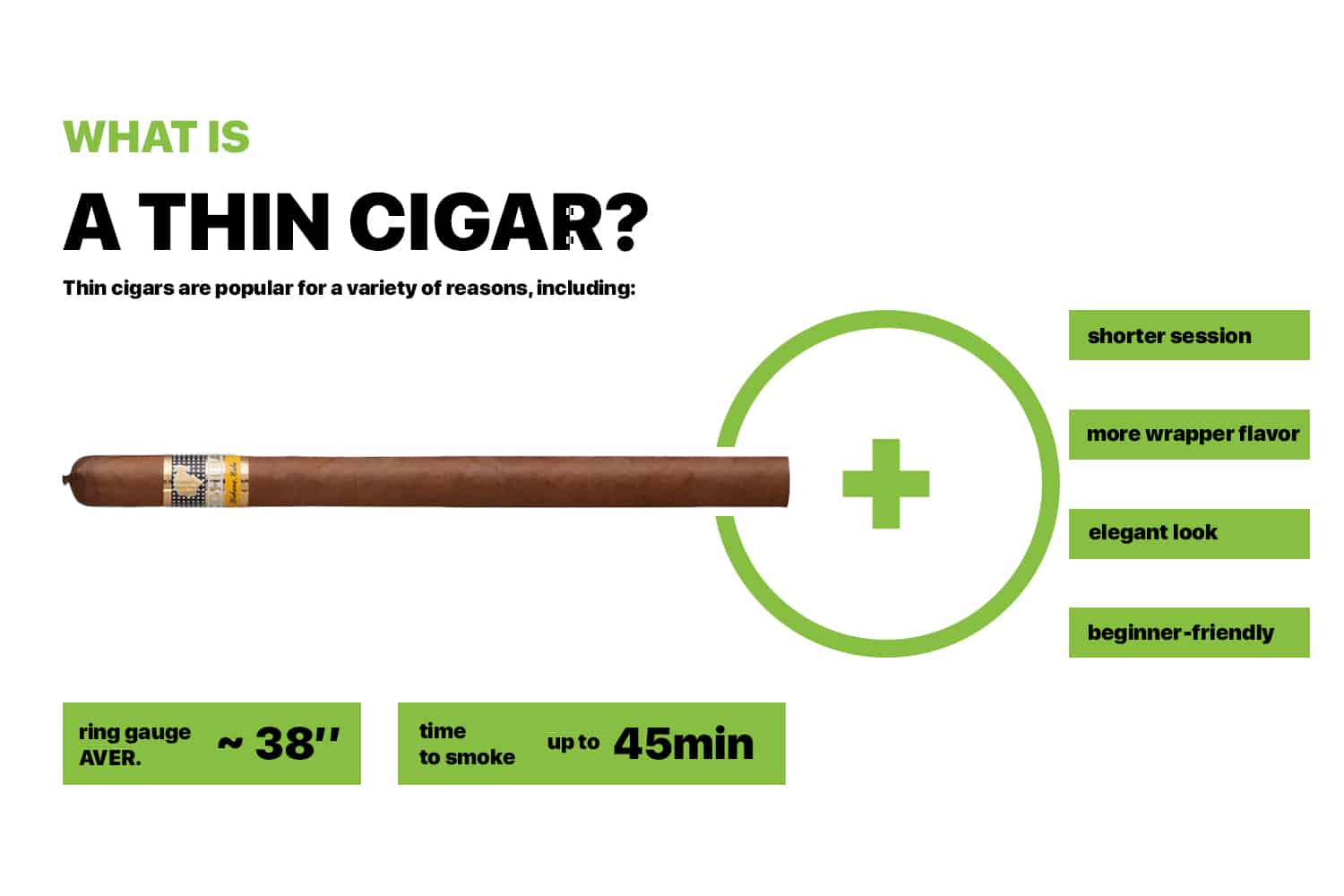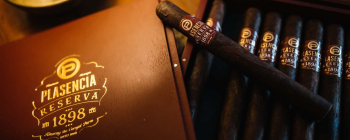
What Are Thin Cigars? The Difference Between Thin and Thick Cigars
Elegant in appearance and intense to taste, thin cigars are popular among smokers new and old. Their smaller ring gauges make them accessible for newcomers, as well as their shorter smoking time. Experienced smokers aren’t left out, as thin cigars produce an array of strong flavors.
In this article, we’ll define what a thin cigar is, explaining why it stands out among other cigars. We’ll also offer you a direct comparison between thin and thick cigars to help you find your preference.
What is a Thin Cigar?

The average ring gauge for a cigar is around 50, which measures to 50/64s of an inch. Thin or ‘slim’ cigars are substantially skinnier, typically with ring gauges of around 38. In some cases, super skinny cigars will have ring gauges as low as 23. For context, the average ring gauge of a cigarette is 19.
Thin cigars are popular for a variety of reasons, including:
- Shorter smoking time: Thinner cigars have less tobacco inside, which lowers the time it takes to smoke them. They are ideal if you don’t have a lot of time on your hands.
- Appearance: There’s a touch of elegance and sophistication associated with thin cigars. They are often seen as a stylish alternative to regular cigars. They add refinement and class to the smoking experience.
- Intense flavors: Thin cigars burn hotter than thicker alternatives. This creates an intensity of flavor, most of which is dictated by the cigar wrapper.
- Easy for beginners: Slim cigars provide a great entry point for beginners. They don’t tend to require over 45 minutes of your time to smoke, making them manageable.
Other Thin Cigar Characteristics
Having a smaller ring gauge changes more than just the flavor and intensity of the cigar. In fact, it changes the entire experience of the smoke. Here’s how:
- Tighter draw: The packed filling of thinner cigars can often restrict airflow through the cigar. This leads to a tighter draw than what you’d experience with a larger cigar.
- Emphasis on the wrapper: The wrapper is often the most flavorsome part of the cigar. When you smoke a thick cigar, this flavor is diluted by the higher proportion of filler inside the stick. So, when you have a thin cigar, the wrapper’s flavors are more pronounced.
- Variety: The cigar’s ring gauge is just a part of its character. There are many different forms of thin cigars, with various flavor profiles. There are also thin cigars at all sections of the price spectrum.
Thin vs Thick Cigars
The aesthetic difference between thin and thick cigars is something you’ll instantly notice. However, thin cigars have many factors that differentiate them from other types of cigars. These include flavor profiles/intensity, pricing, and burn times.
Flavor Profile
The flavor profiles between the two types of cigars vary greatly, mainly because of how they burn. Thicker cigars burn slower and a lot cooler, which produces more smoke. This allows different flavors to develop. These flavors tend to be richer and more nuanced, enjoyed over long periods of time.
Thinner cigars burn hotter because of restricted airflow. This leads to intense flavors coming through, with the wrapper leaf playing a large part. While some smokers will enjoy the intensity, others may find the flavors to be too harsh or bitter.
Strength
The strength of the cigar isn’t actually affected by its thickness. This is instead down to the type of tobacco blend used in the cigar. The perceived strength of the cigar may be altered due to the hotter burn experienced by thin cigars. Slim cigars have a greater intensity to them because of their burn temperature.
Ring Gauge
The ring gauge is an instantly noticeable difference between thin and thick cigars. Thin cigars tend to have a ring gauge no larger than 42, with some going as low as 26. Thicker cigars, such as Gordos, can sometimes have ring gauges exceeding 60.
Smoking time
Because they contain more filler, thick cigars take longer to smoke than thin ones. This remains the case, even if the thicker cigar is shorter in length than the thin cigar. Thickness has a much greater effect on burn time than length, because of the tobacco inside.
There are a handful of thin cigars that will provide you with a decent burn time. Formats such as the Lonsdale measure up to seven inches in length, taking an hour to smoke.
Price
Ultimately, the price of cigars depends on the manufacturer and product quality. A premium Cuban thin cigar will cost you more than a mass-produced thick cigar, for example. If both options are premium quality, the thicker cigar will often be more expensive.
This is because the thicker cigar will contain more tobacco and have a larger wrapper leaf. Thick cigars require greater craftsmanship to roll, which further adds to the price. There’s also the issue of perceived value to consider, which can increase prices for thick cigars.
Types & Formats of Thin Cigars
Looking to start your venture into thin cigars? Here are some of the different types that are available to you. Each offering varies in length and ring gauge, giving you plenty of unique options to choose from.
- Panetela: Panetelas are known for their long, thin shape. They range from five to seven inches in length, with ring gauges between 34 and 38. With a high proportion of wrapper to filler, panetelas have a pronounced flavor.
- Lancera: At around seven inches in length, lanceras are long cigars. They have an average ring gauge between 38 and 40. Like panetelas, the wrapper-to-filler ratio produces intensity. You’ll often find lanceras with pigtail caps, giving them a unique appearance.
- Petit Corona: Petit coronas follow a specific set of guidelines to achieve their shape. At five inches in length and with a ring gauge of 42, petit coronas are perfect for a short smoke.
- Lonsdale: Lonsdale cigars are known for their extended length, measuring between 6-7 inches. The ring gauge of a Lonsdale usually falls between 42 and 44. If you want a balanced flavor profile, they are a great option.
- Cigarillo: Size-wise, cigarillos bridge the gap between cigars and cigarettes. They burn hot and can sometimes be smoked within a quarter of an hour. Because of their small size, cigarillos are less expensive than most cigars.
- Cheroot: Unlike most other cigar types, both ends of a cheroot cigar are clipped. They are not tapered and are easy to roll, making them an inexpensive option.
Find Your Ideal Thin Cigar With Swiss Cuban Cigars
Finding the right skinny cigar for you is a revelatory moment. With Swiss Cuban Cigars, the search is made simple. We have a broad range of thin cigars to choose from, with each of our offerings having our stamp of approval.
We stock cigars from Cuba and beyond, so you’re guaranteed to find the premium product that suits you.Browse our collection of thin cigars today to find a stick that suits you.
Oct 07, 2025
Last Modified: Oct 07, 2025

Table of Contents

